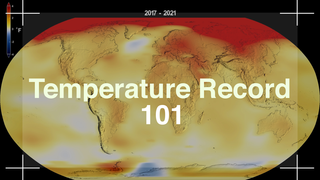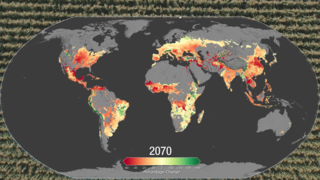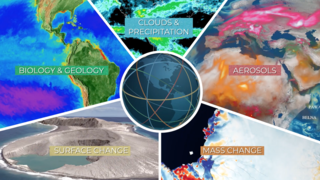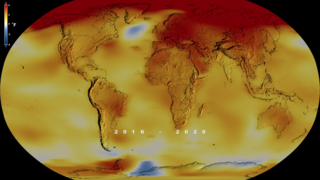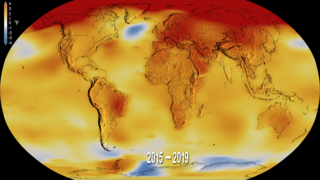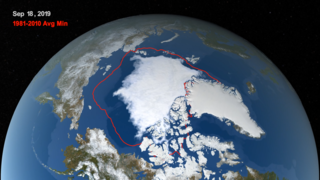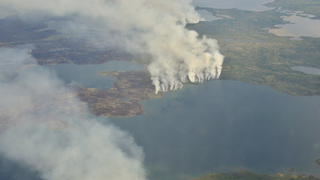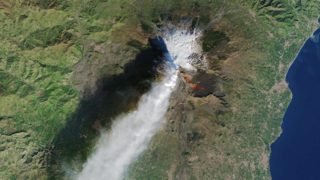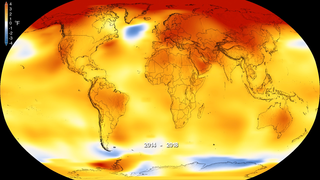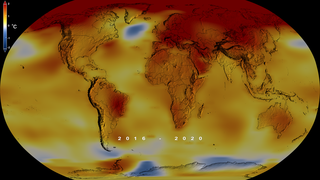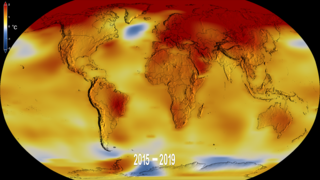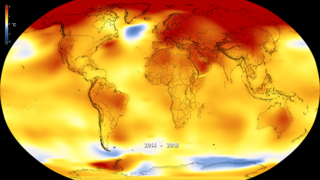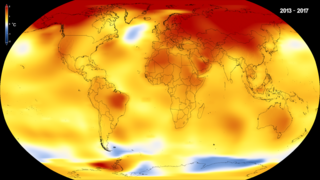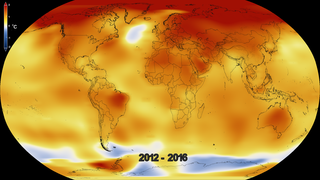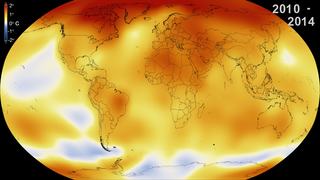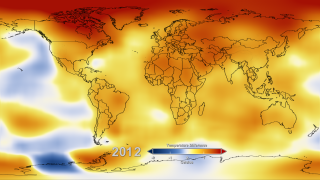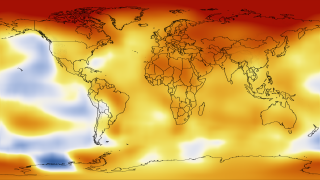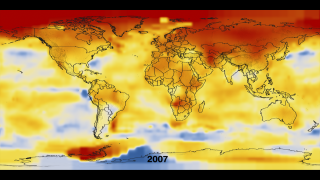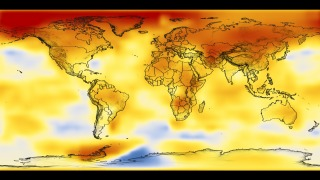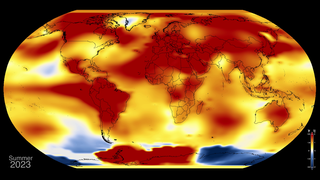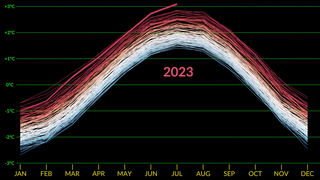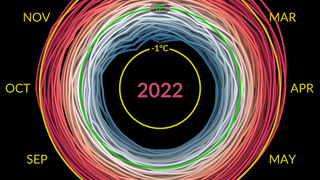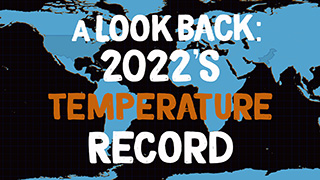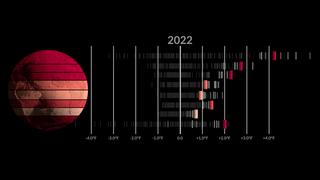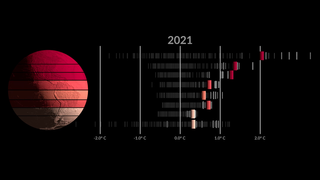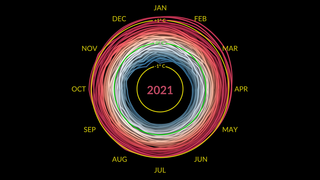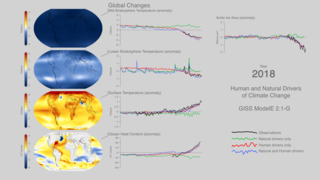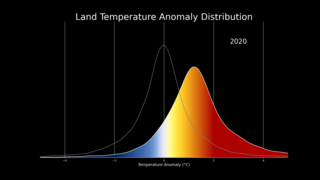Earth
ID: 5060
NASA Reports 2022 Tied for 5th Warmest Year on Record, Continuing a Trend
Earth's global average surface temperature in 2022 tied with 2015 as the fifth warmest on record, according to an analysis by NASA. Continuing the planet's long-term warming trend, global temperatures in 2022 were 1.6 degrees Fahrenheit (0.89 degrees Celsius) above the average for NASA's baseline period (1951-1980), scientists from NASA's Goddard Institute for Space Studies (GISS) reported.
The past nine years have been the warmest years since modern recordkeeping began in 1880. This means Earth in 2022 was about 2 degrees Fahrenheit (or about 1.11 degrees Celsius) warmer than the late 19th century average.
“The reason for the warming trend is that human activities continue to pump enormous amounts of greenhouse gases into the atmosphere, and the long-term planetary impacts will also continue,” said Gavin Schmidt, director of GISS, NASA's leading center for climate modeling.
Human-driven greenhouse gas emissions have rebounded following a short-lived dip in 2020 due to the COVID-19 pandemic. Recently, international scientists, including those at NASA, determined carbon dioxide emissions were the highest on record in 2022. NASA also identified some super-emitters of methane – another powerful greenhouse gas – using the Earth Surface Mineral Dust Source Investigation instrument that launched to the International Space Station earlier this year.
The Arctic region continues to experience the strongest warming trends – close to four times the global average – according to new GISS research presented at the 2022 annual meeting of the American Geophysical Union and a separate study.
NASA uses the period from 1951-1980 as a baseline to understand how global temperatures change over time. That baseline includes climate patterns such as La Niña and El Niño, as well as unusually hot or cold years due to other factors, ensuring that it encompasses natural variations in Earth's temperature.
Many factors can affect the average temperature in any given year. For example, 2022 was one of the warmest on record despite a third consecutive year of La Niña conditions in the tropical Pacific Ocean. NASA scientists estimate that La Niña’s cooling influence may have lowered global temperatures slightly (about 0.11 degrees Fahrenheit or 0.06 degrees Celsius) from what the average would have been under more typical ocean conditions.
A separate, independent analysis by the National Oceanic and Atmospheric Administration (NOAA) concluded that the global surface temperature for 2022 was the sixth highest since 1880. NOAA scientists use much of the same raw temperature data in their analysis and have a different baseline period (1901-2000) and methodology. Although rankings for specific years can differ slightly between the records, they are in broad agreement and both reflect ongoing long-term warming.
NASA's full dataset of global surface temperatures through 2022, as well as full details with code of how NASA scientists conducted the analysis, are publicly available from GISS.
GISS is a NASA laboratory managed by the Earth Sciences Division of the agency's Goddard Space Flight Center in Greenbelt, Maryland. The laboratory is affiliated with Columbia University's Earth Institute and School of Engineering and Applied Science in New York.
For more information about NASA's Earth science programs, visit:
https://www.nasa.gov/earth



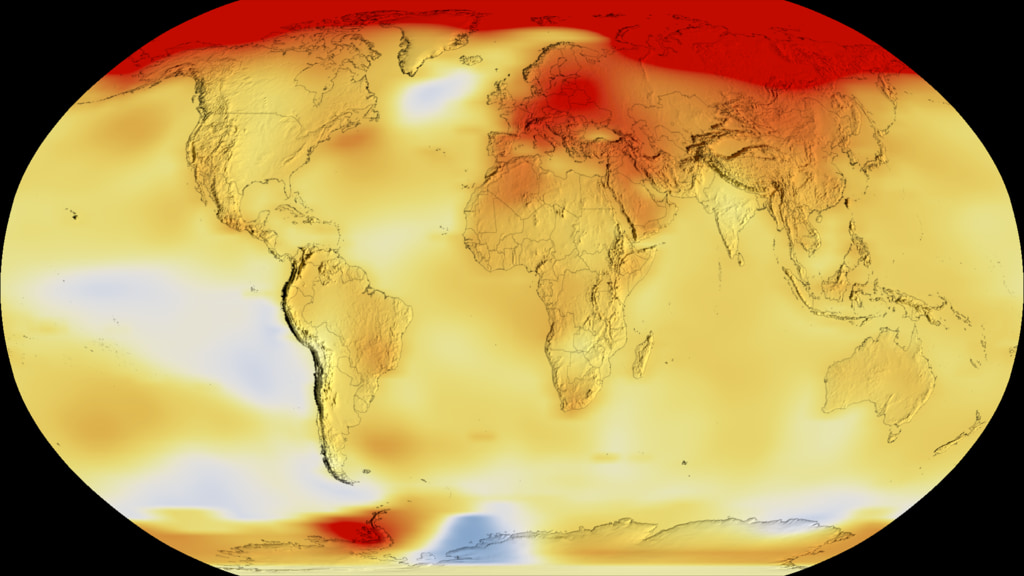
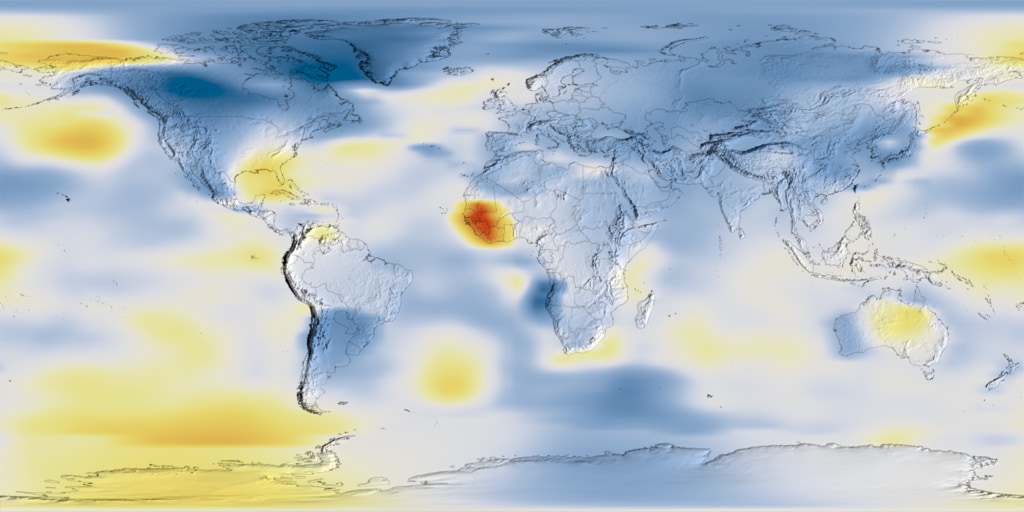

Global Temperature Anomalies from 1880 to 2022
Earth's global average surface temperature in 2022 tied with 2015 as the fifth warmest on record, according to an analysis by NASA. Continuing the planet's long-term warming trend, global temperatures in 2022 were 1.6 degrees Fahrenheit (0.89 degrees Celsius) above the average for NASA's baseline period (1951-1980), scientists from NASA's Goddard Institute for Space Studies (GISS) reported.
The past nine years have been the warmest years since modern recordkeeping began in 1880. This means Earth in 2022 was about 2 degrees Fahrenheit (or about 1.11 degrees Celsius) warmer than the late 19th century average.
“The reason for the warming trend is that human activities continue to pump enormous amounts of greenhouse gases into the atmosphere, and the long-term planetary impacts will also continue,” said Gavin Schmidt, director of GISS, NASA's leading center for climate modeling.
Human-driven greenhouse gas emissions have rebounded following a short-lived dip in 2020 due to the COVID-19 pandemic. Recently, international scientists, including those at NASA, determined carbon dioxide emissions were the highest on record in 2022. NASA also identified some super-emitters of methane – another powerful greenhouse gas – using the Earth Surface Mineral Dust Source Investigation instrument that launched to the International Space Station earlier this year.
The Arctic region continues to experience the strongest warming trends – close to four times the global average – according to new GISS research presented at the 2022 annual meeting of the American Geophysical Union and a separate study.
NASA uses the period from 1951-1980 as a baseline to understand how global temperatures change over time. That baseline includes climate patterns such as La Niña and El Niño, as well as unusually hot or cold years due to other factors, ensuring that it encompasses natural variations in Earth's temperature.
Many factors can affect the average temperature in any given year. For example, 2022 was one of the warmest on record despite a third consecutive year of La Niña conditions in the tropical Pacific Ocean. NASA scientists estimate that La Niña’s cooling influence may have lowered global temperatures slightly (about 0.11 degrees Fahrenheit or 0.06 degrees Celsius) from what the average would have been under more typical ocean conditions.
A separate, independent analysis by the National Oceanic and Atmospheric Administration (NOAA) concluded that the global surface temperature for 2022 was the sixth highest since 1880. NOAA scientists use much of the same raw temperature data in their analysis and have a different baseline period (1901-2000) and methodology. Although rankings for specific years can differ slightly between the records, they are in broad agreement and both reflect ongoing long-term warming.
NASA's full dataset of global surface temperatures through 2022, as well as full details with code of how NASA scientists conducted the analysis, are publicly available from GISS.
GISS is a NASA laboratory managed by the Earth Sciences Division of the agency's Goddard Space Flight Center in Greenbelt, Maryland. The laboratory is affiliated with Columbia University's Earth Institute and School of Engineering and Applied Science in New York.
For more information about NASA's Earth science programs, visit:
https://www.nasa.gov/earth






Used Elsewhere In
Older Versions
Related
Visualization Credits
Lori Perkins (NASA/GSFC): Lead Visualizer
Gavin A. Schmidt (NASA/GSFC GISS): Lead Scientist
Robert B Schmunk Ph.D. (SIGMA Space Partners, LLC.): Scientist
Reto A. Ruedy Ph.D. (SIGMA Space Partners, LLC.): Scientist
Kathryn Mersmann (USRA): Lead Producer
Katie Jepson (USRA): Lead Producer
Peter H. Jacobs (NASA/GSFC): Public Affairs Officer
Kathleen Gaeta (Advocates in Manpower Management, Inc.): Lead Producer
Sofie Bates (KBR Wyle Services, LLC): Producer
Mark SubbaRao (NASA/GSFC): Visualizer
Sally Younger (NASA/JPL): Writer
Gavin A. Schmidt (NASA/GSFC GISS): Lead Scientist
Robert B Schmunk Ph.D. (SIGMA Space Partners, LLC.): Scientist
Reto A. Ruedy Ph.D. (SIGMA Space Partners, LLC.): Scientist
Kathryn Mersmann (USRA): Lead Producer
Katie Jepson (USRA): Lead Producer
Peter H. Jacobs (NASA/GSFC): Public Affairs Officer
Kathleen Gaeta (Advocates in Manpower Management, Inc.): Lead Producer
Sofie Bates (KBR Wyle Services, LLC): Producer
Mark SubbaRao (NASA/GSFC): Visualizer
Sally Younger (NASA/JPL): Writer
Please give credit for this item to:
NASA's Scientific Visualization Studio
Data provided by Robert B. Schmunk (NASA/GSFC GISS)
NASA's Scientific Visualization Studio
Data provided by Robert B. Schmunk (NASA/GSFC GISS)
Short URL to share this page:
https://svs.gsfc.nasa.gov/5060
Data Used:
Note: While we identify the data sets used in these visualizations, we do not store any further details nor the data sets themselves on our site.
This item is part of this series:
Global Temperature Anomalies
Keywords:
SVS >> Anomaly
SVS >> Climate
SVS >> Global Warming
SVS >> HDTV
DLESE >> Physical oceanography
GCMD >> Earth Science >> Oceans >> Coastal Processes >> Sea Level Rise
SVS >> Model Data
SVS >> Hyperwall
SVS >> Science On a Sphere
NASA Science >> Earth
NASA Earth Science Focus Areas >> Climate Variability and Change
GCMD keywords can be found on the Internet with the following citation: Olsen, L.M., G. Major, K. Shein, J. Scialdone, S. Ritz, T. Stevens, M. Morahan, A. Aleman, R. Vogel, S. Leicester, H. Weir, M. Meaux, S. Grebas, C.Solomon, M. Holland, T. Northcutt, R. A. Restrepo, R. Bilodeau, 2013. NASA/Global Change Master Directory (GCMD) Earth Science Keywords. Version 8.0.0.0.0
https://svs.gsfc.nasa.gov/5060
Data Used:
GISS Surface Temperature Analysis (GISTEMP)/GISTEMP
Model - NASA/GISS - 1880-2021This item is part of this series:
Global Temperature Anomalies
Keywords:
SVS >> Anomaly
SVS >> Climate
SVS >> Global Warming
SVS >> HDTV
DLESE >> Physical oceanography
GCMD >> Earth Science >> Oceans >> Coastal Processes >> Sea Level Rise
SVS >> Model Data
SVS >> Hyperwall
SVS >> Science On a Sphere
NASA Science >> Earth
NASA Earth Science Focus Areas >> Climate Variability and Change
GCMD keywords can be found on the Internet with the following citation: Olsen, L.M., G. Major, K. Shein, J. Scialdone, S. Ritz, T. Stevens, M. Morahan, A. Aleman, R. Vogel, S. Leicester, H. Weir, M. Meaux, S. Grebas, C.Solomon, M. Holland, T. Northcutt, R. A. Restrepo, R. Bilodeau, 2013. NASA/Global Change Master Directory (GCMD) Earth Science Keywords. Version 8.0.0.0.0
